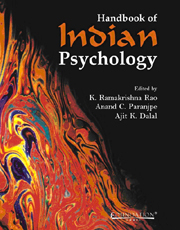Book contents
- Frontmatter
- Contents
- Contributing Authors
- Preface
- 01 Prologue: Introducing Indian Psychology
- 02 Indian Thought and Tradition: A Psychohistorical Perspective
- PART I SYSTEMS AND SCHOOLS
- 03 Jaina Psychology
- 04 The Foundations of Early Buddhist Psychology
- 05 Varieties of Cognition in Early Buddhism
- 06 A Buddhist Theory of Unconscious Mind (Ālaya-Vijñāna)
- 07 Indian Buddhist Theories of Persons
- 08 Buddhist Psychology: A Western Interpretation
- 09 Transpersonal Psychology in the Bhagavad-Gītā: Reflections on Consciousness, Meditation, Work and Love
- 10 Yoga Psychology: Theory and Application
- 11 Patañjali Yoga and Siddhis: Their Relevance to Parapsychological Theory and Research
- 12 Yoga Psychology and the, Sāṃkhyā Metaphysic
- 13 Psychology in the Advaita Vedānta
- 14 The Nyāya-Vaiśeṣika Theory of Perceiving the World of our Experience
- 15 Psychological Theories and Practices in Āyurveda
- PART II TOPICS AND THEMES
- PART III APPLICATIONS AND IMPLICATIONS
- Pronunciation and Transliteration of Sanskrit Alphabet
- Glossary
- Index
07 - Indian Buddhist Theories of Persons
from PART I - SYSTEMS AND SCHOOLS
Published online by Cambridge University Press: 26 October 2011
- Frontmatter
- Contents
- Contributing Authors
- Preface
- 01 Prologue: Introducing Indian Psychology
- 02 Indian Thought and Tradition: A Psychohistorical Perspective
- PART I SYSTEMS AND SCHOOLS
- 03 Jaina Psychology
- 04 The Foundations of Early Buddhist Psychology
- 05 Varieties of Cognition in Early Buddhism
- 06 A Buddhist Theory of Unconscious Mind (Ālaya-Vijñāna)
- 07 Indian Buddhist Theories of Persons
- 08 Buddhist Psychology: A Western Interpretation
- 09 Transpersonal Psychology in the Bhagavad-Gītā: Reflections on Consciousness, Meditation, Work and Love
- 10 Yoga Psychology: Theory and Application
- 11 Patañjali Yoga and Siddhis: Their Relevance to Parapsychological Theory and Research
- 12 Yoga Psychology and the, Sāṃkhyā Metaphysic
- 13 Psychology in the Advaita Vedānta
- 14 The Nyāya-Vaiśeṣika Theory of Perceiving the World of our Experience
- 15 Psychological Theories and Practices in Āyurveda
- PART II TOPICS AND THEMES
- PART III APPLICATIONS AND IMPLICATIONS
- Pronunciation and Transliteration of Sanskrit Alphabet
- Glossary
- Index
Summary
In the sixth century BCE the Buddha presented an eightfold path a person is to follow in order to become liberated from suffering in saṃsāra. This eightfold path involves the use of wisdom (prajñā) and skillful means (upāya) to prepare oneself to acquire the wisdom needed to achieve liberation. Included in the skillful means part of the path are the practise of yogic meditation, of the sort explained in Patañjali's Yoga-Sūtras, and the practise of spiritual discipline (śīla), which consists primarily of the performance of skillful action (karma) that enables persons to be reborn in the human realm and creates the other conditions favourable to the acquisition of wisdom. Some of the Buddha's later followers claimed that he had taught only a path to the goal of individual liberation from suffering and others claimed that he had also taught a path to the goal of universal liberation. Those who practise the first are now called the Therāvādins and those who practise the second are the Mahāyānists. The practise of wisdom itself includes the acquisition of meditative knowledge of both the workings of the mind and the ultimate nature of its objects, which include the mind itself. Over time different schools of wisdom were formed by the Buddha's followers, each claiming that it alone correctly represents his teachings. Four basic schools, each with a number of different subschools, emerged by the ninth century CE. Indian Buddhist theories of persons were formulated in the wisdom schools in the context of explaining why a person suffers in saṃsāra and how he can become free from this suffering.
- Type
- Chapter
- Information
- Handbook of Indian Psychology , pp. 129 - 141Publisher: Foundation BooksPrint publication year: 2008
- 1
- Cited by

